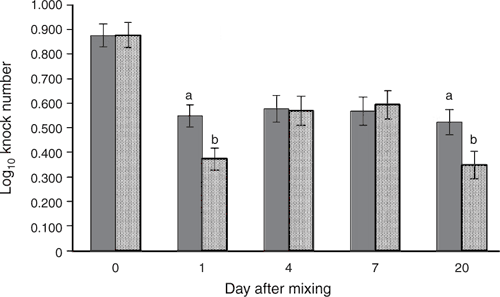Provision of novel materials reduced knocks and injuries and increased play in sows following mixing
E. C. Greenwood A C , J. R. Rayner B , K. J. Plush B , W. H. E. J. van Wettere A and P. E. Hughes BA The University of Adelaide, Roseworthy, SA 5371.
B South Australian Research and Development Institute, Roseworthy, SA 5371.
C Corresponding author. Email: emma.greenwood@adelaide.edu.au
Animal Production Science 55(12) 1494-1494 https://doi.org/10.1071/ANv55n12Ab020
Published: 11 November 2015
Aggression between sows at mixing is unavoidable. Although a natural behaviour, aggression between unfamiliar pigs is a welfare concern due to the associated injury and stress. Management around the time of mixing can mitigate the short-term nature of this stress response (Arey and Edwards 1998). One parameter that can be managed to reduce aggression and stress in sows is enrichment or addition of novel materials. The aim of this experiment was to determine the effect of the presence of novel materials on the aggression between sows at mixing. It was hypothesised that if the novel materials were a source of interest for the sows and not a limiting resource, then they would decrease aggression following mixing.
The experiment used 144 multiparous, Large White x Landrace sows. Following artificial insemination, sows were mixed into groups of 12 and allowed space of 2 m2/sow. Sows were allocated to either a standard pen or a novel environment pen, with the latter having eight hanging ropes, two hanging yellow disks and two hanging rubber mats. The sows remained in these pens until ultrasound scanning for pregnancy, after which all sows were moved into a shelter (approximately d 30). Injury counts and behaviours (6 hours, including eating, fighting, knocks, bites, rest and exploration) were measured on d 0, 1, 4, 7 and 20 relative to mixing. Data were analysed using a linear mixed model (IBM SPSS, Version 20.0; USA) with sow identification fit as a random effect, and replicate, sow parity, day of measure and treatment as fixed effects. For injury counts, the d -1 measure was fitted as a covariate. Data are expressed as least squares means ± SEM. Where statistical transformations occurred, the non-transformed means have been presented in parentheses.
The number of knocks delivered was significantly altered by treatment and day (P < 0.05; Fig. 1), with fewer knocks in the novel pen than the standard pen on d 1 (4.9 versus 3.0) and d 20 after mixing (4.4 vs 3.1). The total numbers of injuries was decreased by the presence of novel materials on both d 4 [5.0 ± 0.2 (27.6) vs 5.5 ± 0.2 (35.0)]) and d 20 [3.5 ± 0.2 (15.0) vs 4.2 ± 0.2 (20.6)]) after mixing (P < 0.01). The percentage time that sows spent excitedly playing, a behaviour not recorded in the standard pens, increased significantly over the experimental period in the novel pens, with sows playing with the materials more on d 7 and 20 than on d 0, 1 and 4 (P = 0.02).

|
The presence of novel materials decreased aggression and injuries, both of which could indicate welfare benefits. Given that the amount of time that sows spent playing with the novel materials increased over the 20-day study period, it can be concluded that the enrichment successfully engaged the sow’s attention, and habituation to the materials did not occur over this time frame. Therefore, increased play elicited by enrichment, suggest that the presence of the materials may have improved sow welfare, if only minimally affecting aggression at mixing.
References
Arey DS, Edwards SA (1998) Livestock Production Science 56, 61–70.| Crossref | GoogleScholarGoogle Scholar |
Supported by Pork CRC Limited Australia and The University of Adelaide.


 and pens containing novel materials
and pens containing novel materials  following mixing. Data are log10-transformed means ± SEM. Significant differences between treatment within day are highlighted using superscripts (a,bP < 0.01).
following mixing. Data are log10-transformed means ± SEM. Significant differences between treatment within day are highlighted using superscripts (a,bP < 0.01).